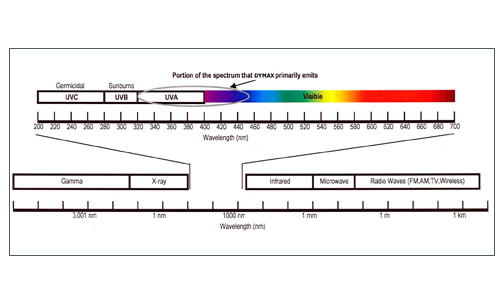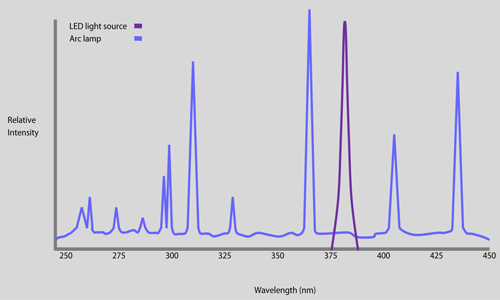LED UV 与广谱固化波长
电磁波谱是所有已知频率及其相关波长的统称,已知光子(电磁辐射)。光谱是以光速传播的极其广泛的辐射范围,根据波长分为不同的区域,从无线电波(~1 米 - 11 千米)到可见光和紫外线(~300-800 纳米)再到伽马射线(~0.001 纳米),如下图 1 所示。紫外线是电磁波谱中介于 X 射线和可见光相邻的较短波长范围。可见光是电磁波谱中眼睛可以看到的唯一部分。这些区域中的波长通常以纳米 (nm) 为单位。一纳米是十亿分之一米或千分之一微米。UVA 范围通常被认为是三种紫外线范围(UVA、UVB 和 UVC)中最安全的。
广谱固化
传统的汞弧灯,例如 BlueWave® 200 V.3被认为是宽带光源,因为它们发射的光线波长范围很广,包括短波紫外线、长波可见光,甚至更长波红外线,从而产生多个能量峰值。广谱固化系统利用高压金属卤化物灯,产生 300 至 450 nm 范围内的光能,并提供 50-1,000 mW/cm 2 UVA 光照射在固化表面。
LED 固化
LED(发光二极管)使用表面安装的 LED 阵列代替传统的金属卤化物或汞灯泡来产生固化能量。它们是半导体能源,发射非常离散的能量波长,从而产生单一、狭窄的钟形发射光谱。LED 光源(例如 BlueWave® AX-550 V 2.0 ,峰值可在紫外线或可见光范围内,通常在 365、385 或 405 nm,具体取决于 LED 的选择。图 2 说明了弧光灯和 LED 光源之间的波长分布差异。
有关 LED 固化的更多信息,请与我们的一位技术专家联系。


